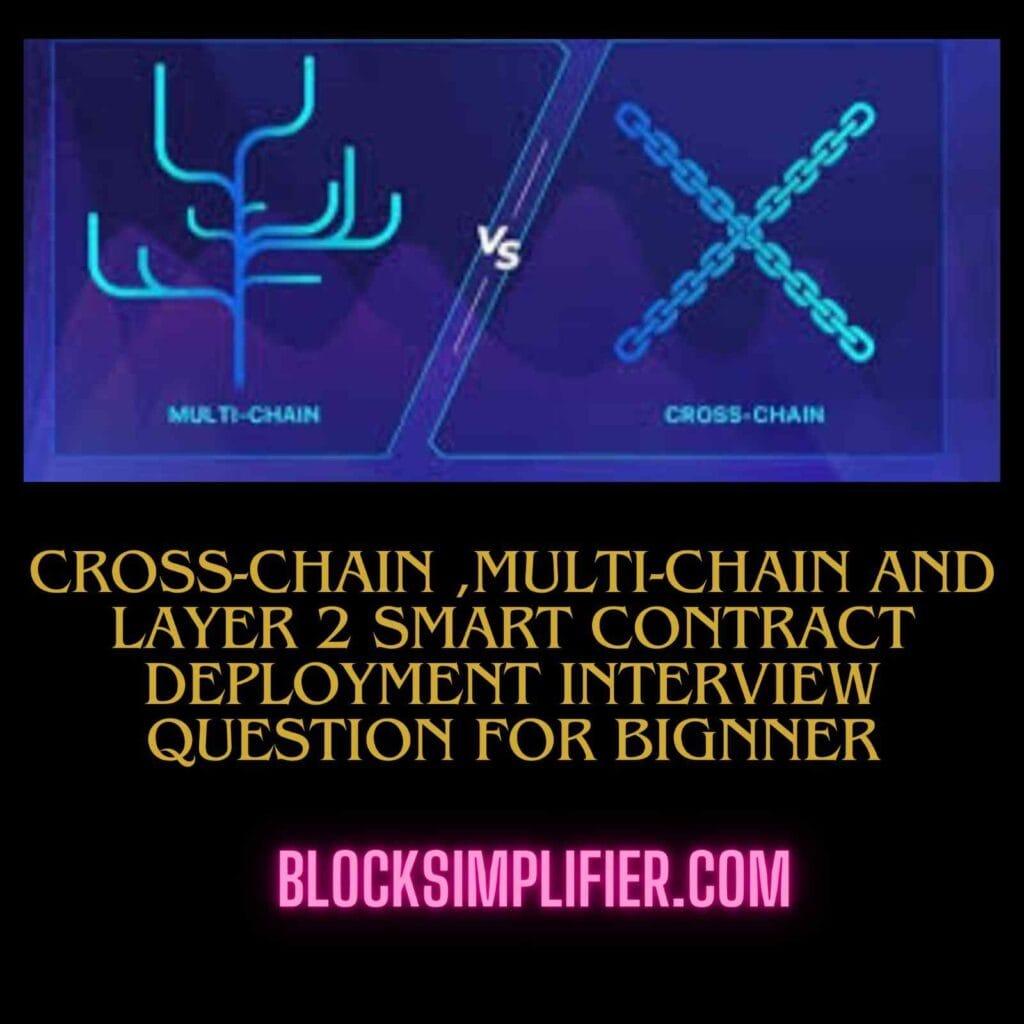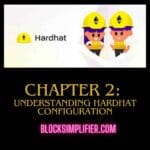Here are the most frequently asked interview questions about cross-chain smart contract deployment,and Multi chain & Layer 2 Smart Contract Deployment
Table of Contents
Cross-chain smart contract deployment
1. What is a cross-chain smart contract?
A cross-chain smart contract permits an an interplay between one-of-a-kind blockchain networks, permitting seamless asset transfers and interoperability.
2. What are the common approaches for cross-chain communication?
Common methods include:
- Oracles (e.g., Chainlink CCIP)
- Relayers (e.g., Axelar, LayerZero)
- Bridges (e.g., Wormhole, Synapse)
- Light Clients & SPV (Simplified Payment Verification)
3. What is LayerZero, and how does it enable cross-chain communication?
LayerZero is an interoperability protocol that lets in smart contracts on one of a kind blockchains to speak via Ultra Light Nodes (ULN). It reduces gas fees whilst preserving protection.
4. How do you deploy a smart contract on multiple chains using Hardhat?
Steps:
- Configure networks in
hardhat.config.js - Write a deploy script
- Use
npx hardhat run scripts/deploy.js --network <chain>
5. What is the role of a cross-chain bridge?
A bridge permits belongings and records to move between chains through locking tokens on one chain and minting wrapped versions on another.
6. How does a cross-chain relayer work?
A relayer listens for events on one chain and submits transactions to another, ensuring state consistency across chains.
7. What are the security risks in cross-chain contracts?
Risks include:
- Replay attacks
- Bridge vulnerabilities
- Validator collusion
- Fake deposits (double-spend risks)
8. How do you verify a contract on multiple chains?
Use Hardhat Etherscan Plugin:
npx hardhat verify --network polygon <contract_address>
9. What is a cross-chain message passing (CCMP)?
CCMP allows contracts to send messages across chains using event listeners and relayers.
10. What is an Omni-chain contract?
Omni-chain contracts work natively on multiple chains without needing relayers or wrapped assets (e.g., LayerZero’s OApp).
11. How do you ensure atomic transactions in cross-chain execution?
Use a cross-chain execution framework like Hyperlane or Axelar to bundle transactions into a single, all-or-nothing execution.
12. How does LayerZero prevent message tampering?
LayerZero ensures security via:
- Relayers & oracles for message verification
- Nonce tracking to prevent replay attacks
13. How do you test a cross-chain smart contract?
Use Hardhat fork mode:
npx hardhat node --fork <RPC_URL>
14. What is a wrapped token in a cross-chain bridge?
A wrapped token is a tokenized version of an asset from another chain (e.G., wETH on BSC represents ETH from Ethereum).
15. How do you handle gas fees across chains?
Users must hold native tokens on each chain, or use gas stations like Gelato or Biconomy.
16. What is an example of a cross-chain NFT marketplace?
Magic Eden uses Solana, Ethereum, and Polygon for go-chain NFT trading.
17. How do you prevent front-running in cross-chain transactions?
Use commit-reveal schemes or zk-SNARKs to hide transaction details until execution.
18. What is the main difference between cross-chain and multi-chain?
- Cross-chain: Contracts communicate across chains.
- Multi-chain: Contracts exist separately on multiple chains without interaction.
19. What is a decentralized message-passing protocol?
A protocol like CCIP or IBC (Inter-Blockchain Communication) ensures secure, trustless cross-chain messaging.
20. How does an optimistic bridge work?
Optimistic bridges assume messages are valid unless challenged within a fraud-proof window.
21. What are examples of cross-chain DeFi projects?
ThorChain, Synapse, and Stargate enable cross-chain liquidity and trading.
22. How do you optimize gas costs in cross-chain transactions?
Use LayerZero Ultra Light Nodes (ULN) to reduce message costs.
23. What is a relayer network in cross-chain transactions?
A relayer network is a decentralized system that listens for cross-chain events and submits them to the destination chain.
24. What is a cross-chain governance model?
Cross-chain governance allows DAOs to vote across multiple chains (e.g., Snapshot X).
25. How do you integrate GraphQL for real-time updates in a cross-chain dApp?
Use The Graph to index events from multiple chains and query data via GraphQL.
Layer 2 Smart Contract Deployment
1. What is Layer 2 in blockchain?
Layer 2 (L2) answers are scaling mechanisms built on pinnacle of Layer 1 (L1) blockchains like Ethereum. They lessen gas fees and improve transaction speeds by means of handling transactions off-chain and settling them on L1.
2. What are examples of Layer 2 networks?
Optimistic Rollups: Optimism, Arbitrum
ZK-Rollups: zkSync, StarkNet, Polygon zkEVM
Sidechains: Polygon PoS, Ronin
State Channels: Raiden Network
3. How do Optimistic Rollups work?
Optimistic Rollups batch transactions off-chain and submit the data to Ethereum assuming it is valid. If fraud occurs, a 7-day challenge period allows fraud proofs.
4. How do ZK-Rollups work?
ZK-Rollups use zero-knowledge proofs to verify transactions off-chain and submit only a proof to Ethereum, making transactions faster and cheaper.
5. How do you deploy a smart contract on a Layer 2 network?
Steps:
- Configure network settings in Hardhat
- Compile the contract
- Deploy using
npx hardhat run scripts/deploy.js --network arbitrum
6. How do you verify a smart contract on Layer 2?
Use Hardhat Etherscan Plugin:
npx hardhat verify --network optimism <contract_address>
7. How do you interact with Layer 2 contracts using Ethers.Js?
const provider = new ethers.providers.JsonRpcProvider("<L2_RPC_URL>");
const wallet = new ethers.Wallet("<PRIVATE_KEY>", provider);
const contract = new ethers.Contract("<CONTRACT_ADDRESS>", ABI, wallet);
8. How do Layer 2 solutions reduce gas fees?
They batch multiple transactions into a single proof, reducing on-chain computation and storage costs.
9. How do you bridge tokens from Ethereum to a Layer 2 network?
Use an official bridge, e.g.:
- Optimism Gateway: gateway.optimism.io
- Arbitrum Bridge: bridge.arbitrum.io
10. How do you test a smart contract on a Layer 2 testnet?
Use testnet RPCs:
- Optimism Goerli:
https://goerli.optimism.io - Arbitrum Goerli:
https://goerli-rollup.arbitrum.io/rpc
Then deploy using Hardhat:
npx hardhat run scripts/deploy.js --network optimismGoerli
11. What are the risks of deploying on Layer 2?
Risks include:
- Centralized sequencers (potential censorship)
- Bridge vulnerabilities
- Smart contract bugs
12. How do you integrate a front end with a Layer 2 contract?
Use ethers.js and set the provider to the Layer 2 RPC:
const provider = new ethers.providers.JsonRpcProvider("https://mainnet.optimism.io");
const contract = new ethers.Contract("<CONTRACT_ADDRESS>", ABI, provider);
13. How does Layer 2 transaction finality work?
- Optimistic Rollups: 7-day fraud challenge period
- ZK-Rollups: Instant finality with ZK proofs
14. How do you fetch real-time Layer 2 data in a front-end dApp?
Use The Graph to index Layer 2 contracts and fetch data via GraphQL.
15. How do you enable MetaMask to connect to Layer 2 networks?
Add the network manually or use:
await window.ethereum.request({
method: "wallet_addEthereumChain",
params: [{
chainId: "0xA", // Optimism
rpcUrls: ["https://mainnet.optimism.io"],
chainName: "Optimism",
nativeCurrency: { name: "ETH", symbol: "ETH", decimals: 18 },
blockExplorerUrls: ["https://optimistic.etherscan.io/"]
}]
});
16. How do you handle Layer 2 gas payments in a dApp?
Use a Gasless Relayer like Gelato or Biconomy to pay gas fees for users.
17. How do you store NFTs on Layer 2?
Deploy an ERC-721 contract on a Layer 2 like zkSync to store NFTs with lower minting costs.
18. What is a sequencer in Layer 2?
A sequencer orders transactions before they are posted to L1. In Optimism and Arbitrum, sequencers speed up transactions but are currently centralized.
19. How do you withdraw assets from Layer 2 back to Ethereum?
Use the official bridge and wait for the exit period:
- Optimistic Rollups: 7-day challenge period
- ZK-Rollups: Instant or a few minutes
20. How do you make sure cross-chain compatibility while deploying to Layer 2?
Use LayerZero or Axelar to allow move-chain messaging between L1 and L2.
21. How do you integrate Web3Modal for Layer 2 dApps?
Install Web3Modal and connect wallets:
const providerOptions = {
walletconnect: {
package: WalletConnectProvider,
options: { rpc: { 10: "https://mainnet.optimism.io" } }
}
};
const web3Modal = new Web3Modal({ providerOptions });
22. How do you deploy an upgradeable contract on Layer 2?
Use OpenZeppelin Upgrades Plugin:
npx hardhat deploy --network arbitrum
23. How do you integrate cross-chain messaging in a Layer 2 dApp?
Use LayerZero SDK:
const message = await contract.sendMessage("Hello from Layer 2!");
24. How do you optimize a front-end dApp for Layer 2?
- Use GraphQL Subgraphs for real-time updates
- Reduce RPC calls
- Use batching and multicalls
25. What is an example of a successful Layer 2 dApp?
Immutable X for gaming on zk-rollups
Aave V3 on Arbitrum & Optimism
OpenSea on Polygon.
Multi-Chain Smart Contract Deployment Questions
1. What is a multi-chain smart contract?
A multi-chain clever contract is deployed on multiple blockchain networks (Ethereum, Polygon, BNB Chain, and many others.) but operates independently on every chain.
2. How does multi-chain deployment differ from cross-chain deployment?
Multi-chain: Contracts exist separately on multiple chains.
Cross-chain: Contracts communicate between chains.
3. What are the best tools for multi-chain deployment?
Popular tools:
- Hardhat (for EVM chains)
- Foundry (for faster compilation/testing)
- Remix (for simple contract deployments)
- ThirdWeb (for easy multi-chain deployment)
4. How do you configure Hardhat for multi-chain deployment?
Update hardhat.config.js:
module.exports = {
networks: {
ethereum: { url: process.env.ETH_MAINNET_RPC, accounts: [PRIVATE_KEY] },
polygon: { url: process.env.POLYGON_RPC, accounts: [PRIVATE_KEY] },
bsc: { url: process.env.BSC_RPC, accounts: [PRIVATE_KEY] },
},
};
5. How do you deploy a contract to multiple chains using Hardhat?
Run deploy commands separately:
npx hardhat run scripts/deploy.js --network ethereum
npx hardhat run scripts/deploy.js --network polygon
npx hardhat run scripts/deploy.js --network bsc
6. How can you manage the same contract address across multiple chains?
Use a deterministic deployment strategy like CREATE2 or ThirdWeb’s Multichain Factory.
7. How do you verify a smart contract on multiple chains?
Use Hardhat Etherscan Plugin:
npx hardhat verify --network polygon <contract_address>
8. How do you handle gas fees across different chains?
Options:
- Native tokens on each chain (MATIC, ETH, BNB)
- Gas relayers (Gelato, Biconomy)
- Meta-transactions
9. How do you read a smart contract from different chains in a frontend app?
Use Ethers.js or Web3.js with multiple RPC providers:
const providerPolygon = new ethers.JsonRpcProvider(POLYGON_RPC);
const providerBSC = new ethers.JsonRpcProvider(BSC_RPC);
10. How do you update a multi-chain smart contract after deployment?
Options:
- Deploy a new version and update the frontend.
- Use proxy contracts for upgradeability (e.g., OpenZeppelin’s Transparent Proxy).
11. How do you test multi-chain smart contract interactions?
Use Hardhat forking:
npx hardhat node --fork <RPC_URL>
12. What is an example of a multi-chain DeFi project?
Uniswap and Aave exist on Ethereum, Polygon, and Arbitrum but operate independently.
13. How do you set up multi-chain wallets in the frontend?
Use RainbowKit, Wagmi, or Web3Modal to connect wallets across chains.
14. How do you detect the user’s blockchain network in a frontend app?
Use Ethers.js:
const network = await provider.getNetwork();
console.log("Connected to", network.name);
15. How do you prompt users to switch networks in a dApp?
Use Ethers.js:
await window.ethereum.request({
method: "wallet_switchEthereumChain",
params: [{ chainId: "0x89" }], // Polygon
});
16. How do you handle multi-chain RPC failures in a frontend?
Use fallback RPC providers:
const provider = new ethers.JsonRpcProvider(POLYGON_RPC || BACKUP_RPC);
17. How do you store and retrieve contract addresses per chain in a frontend?
Use JSON mapping:
{
"ethereum": "0xContractAddressETH",
"polygon": "0xContractAddressPOLYGON"
}
18. How do you handle transactions across multiple chains in a dApp?
Use chain selectors in UI and Ethers.js for dynamic transactions:
const contractAddress = addresses[selectedChain];
const contract = new ethers.Contract(contractAddress, abi, signer);
await contract.functionName(args);
19. What is Chain ID, and why is it essential in multi-chain apps?
Chain ID uniquely identifies each blockchain (Ethereum: 1, Polygon: 137). It prevents replay attacks and ensures correct network connections.
20. How do you fetch token balances from multiple chains in a frontend?
Use Multicall with Ethers.js:
const multicallContract = new ethers.Contract(multicallAddress, multicallABI, provider);
const balanceData = await multicallContract.aggregate([
[contractPolygon, "balanceOf", [userAddress]],
[contractBSC, "balanceOf", [userAddress]],
]);
21. How do you display real-time blockchain events from multiple chains?
Use The Graph with GraphQL queries or Ethers.js event listeners:
contract.on("Transfer", (from, to, value) => {
console.log(`Transfer detected on ${selectedChain}: ${value} tokens`);
});
22. How do you manage UI state when switching networks?
Use Redux, Zustand, or Context API to store the selected network.
23. How do you sign messages across different chains?
Use EIP-712 structured signing:
const signature = await signer._signTypedData(domain, types, message);
24. How do you handle token approvals across multiple chains?
Use a single UI component with dynamic contract addresses:
const tokenAddress = tokenAddresses[selectedChain];
const tokenContract = new ethers.Contract(tokenAddress, erc20ABI, signer);
await tokenContract.approve(spender, amount);
25. How do you optimize gas fees in multi-chain transactions?
Best practices:
- Use Layer 2 chains (Polygon, Arbitrum, Optimism)
- Batch transactions with Multicall
- Estimate gas before execution:
const gasEstimate = await contract.estimateGas.functionName(args);




Amazing writing! Sprunki Games is transforming music creation.